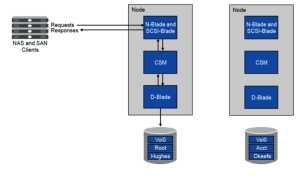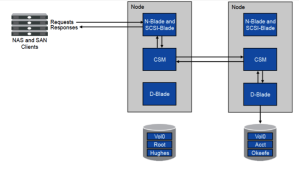Data write request process in Netapp Clustered Data ONTAP
For SEO: data write request process
Clustered ONTAP system can be managed either from CLI or GUI (system manager or element manager). There are three different shells available with different scopes: Clustershell, nodeshell, systemshell
Step:1 Access through CLI
Clustershell:
———
-SSH is default method
-One can access clustershell using cluster management LIF (recommended) or the node management LIFs
-Scope: entire cluster
-One can access clustershell using cluster management LIF (recommended) or the node management LIFs
-Scope: entire cluster
LIFs Management: ‘net int show‘ with display the output of available cluster management and node management LIFs along with their IP’s, current node, current port and status
Nodeshell:
——–
-Access nodeshell within the clustershell
-Scope: limited to one node at a time
-Command to access nodeshell is:
-Scope: limited to one node at a time
-Command to access nodeshell is:
Clus::> system node run
Systemshell:
———
-Access systemshell from within the clustershell
-This is to access BSD shell
-Scope: single node at a time
-To access systemshell:
-This is to access BSD shell
-Scope: single node at a time
-To access systemshell:
a. security login unlock -username diag b. system node systemshell c. Login as “diag”
Step: 2 Access through GUI
-Start the system manager client using the IP address of the cluster management LIF
-This is well known interface to all the existing 7-mode administrators and I don’t think more explanation is needed here
-This is well known interface to all the existing 7-mode administrators and I don’t think more explanation is needed here
Dataflow in NetApp cluster-mode
To understand the dataflow in cluster-mode, one needs to understand the four major software components along with other key software components on every node in the cluster, they are as follows:
a. N-blade, network “blade”
b. D-blade, data “blade”
c. SCSI-blase, SCSI SAN “blade”
d. M-host, Management blade
b. D-blade, data “blade”
c. SCSI-blase, SCSI SAN “blade”
d. M-host, Management blade
Other components:
————–
-The cluster session manager (CSM)
-RDB units, which is the volume location database
-RDB units, which is the volume location database
All the above mentioned components are accessed only by well-defined application APIs. The N-blade and SCSI-blade translates client requests into Spin Network Protocol (SpinNP) requests. The D-blade contains the WAFL file system that handles the SpinNP requests. The CSM is the SpinNP layer between the N-blade, the SCSI-blase and the D-blade.
Key Concepts:
————
N-blade: The N-blade handles the networking, NFS and CIFS requests and then translates to SpinNP requests as inputs to CSM
SCSI-blade: The SCSI-blade handles the networking, FC, FCoE and iSCSI requests and then translates to SpinNP requests as inputs to CSM
CSM: CSM then acts as a communicator between N-bade or SCSI-blade SpinNP requests and input them to the D-blade over UDP/IP
D-blade: The D-blade which contains the WAFL file systems then handles the SpinNP requests and them communicate disks and tape devices using FC
Dataflow on a local node:
——————-
1. NAS or SAN clients sends the write requests to a data logical interface (LIF)
2. N-blade (NAS) or SCSI-blade (SAN) which are associated with that LIF translates the NFS or CIFS, FC, FCoE, or iSCSI request to a SpinNP request
3. The SpinNP requests then passed to the D-blade via CSM
4. D-blade then sends the data to NVRAM and to the disks
5. The acknowledgments then works its way back to the client
2. N-blade (NAS) or SCSI-blade (SAN) which are associated with that LIF translates the NFS or CIFS, FC, FCoE, or iSCSI request to a SpinNP request
3. The SpinNP requests then passed to the D-blade via CSM
4. D-blade then sends the data to NVRAM and to the disks
5. The acknowledgments then works its way back to the client
Dataflow on a Remote node:
——————————————-
1. NAS or SAN clients sends the write requests to a data logical interface (LIF)
2. N-blade (NAS) or SCSI-blade (SAN) which are associated with that LIF translates the NFS or CIFS, FC, FCoE, or iSCSI request to a SpinNP request
3. The SpinNP requests then passed to the “remote” D-blade via Cluster session manager.
4. D-blade then sends the data to NVRAM, NVRAM has two parts one part holds the data which 50% of the NVRAM and time period is 10secs. Whenever first part 50% is fulled it will send to disks for write, either after 10secs it will automatically sends to disks for write when 50% is not full.
5. The acknowledgments then works its way back to the client
2. N-blade (NAS) or SCSI-blade (SAN) which are associated with that LIF translates the NFS or CIFS, FC, FCoE, or iSCSI request to a SpinNP request
3. The SpinNP requests then passed to the “remote” D-blade via Cluster session manager.
4. D-blade then sends the data to NVRAM, NVRAM has two parts one part holds the data which 50% of the NVRAM and time period is 10secs. Whenever first part 50% is fulled it will send to disks for write, either after 10secs it will automatically sends to disks for write when 50% is not full.
5. The acknowledgments then works its way back to the client


No comments:
Post a Comment